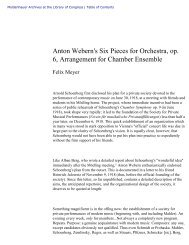Country Profile: Cuba - American Memory - Library of Congress
Country Profile: Cuba - American Memory - Library of Congress
Country Profile: Cuba - American Memory - Library of Congress
Create successful ePaper yourself
Turn your PDF publications into a flip-book with our unique Google optimized e-Paper software.
<strong>Library</strong> <strong>of</strong> <strong>Congress</strong> – Federal Research Division <strong>Country</strong> <strong>Pr<strong>of</strong>ile</strong>: <strong>Cuba</strong>, September 2006<br />
earnings from around US$100 million in 1993 to US$3.1 billion in 2004 and approximately<br />
US$4.1 billion in 2005.<br />
Banking and Finance: Since 1995 <strong>Cuba</strong> has been attempting to restructure its long nationalized<br />
banking system to accommodate a more market-oriented economy, hoping to attract foreign<br />
investment in the energy and mining sectors in particular. Relatively new commercial banks<br />
include the Banco Financiero Internacional and the Banco de Inversiones (for investment),<br />
Banco Metropolitano (<strong>of</strong>fering foreign currency and deposit account facilities), Banco de Crédito<br />
y Comercio, Banco Internacional de Crédito, and Banco Nacional de <strong>Cuba</strong>. <strong>Cuba</strong> also has an<br />
older savings bank, the Banco Nacional de Ahorro, and 13 foreign banks (most <strong>of</strong> which are<br />
European). New rules issued since 2004 have enhanced the ability <strong>of</strong> the Central Bank <strong>of</strong> <strong>Cuba</strong><br />
to monitor and control hard-currency credit creation in the country’s monetary system. With the<br />
allocation <strong>of</strong> financial resources continuing to shift from the central planning authorities toward<br />
the banking system, the Central Bank is expected to play an increasingly important role in<br />
macroeconomic management, although the large informal economy’s differing markets and<br />
divergent prices complicate monetary management. <strong>Cuba</strong>’s financing requirement is expected to<br />
double in 2006 to about US$1 billion.<br />
Labor: The labor force totaled at least 4.6 million people in 2004 and 4.7 million in 2005 but<br />
possibly as many as 6.7 million in both years and in 2006. Before the Revolution, women<br />
constituted less than 20 percent <strong>of</strong> the labor force. By the end <strong>of</strong> the century, however, that figure<br />
had risen to 44 percent, and the health sector alone employed 73.2 percent <strong>of</strong> women in the<br />
workforce. Although agriculture (including hunting, forestry, and fishing) employed 40 percent<br />
<strong>of</strong> the population in 1960, by 2002 it employed only about 26 percent <strong>of</strong> the economically active<br />
population. In 2002 the manufacturing industry employed 14 percent <strong>of</strong> the workforce (an<br />
increase <strong>of</strong> only 1 percent since 1960) and the services sector about 53 percent. Although the<br />
state sector accounted for 95.4 percent <strong>of</strong> total civilian employment in 1989, by 2003 this<br />
percentage had declined to 73.2 percent as a result <strong>of</strong> the economic reforms <strong>of</strong> the 1990s. About<br />
one-third <strong>of</strong> the employees in the state sector are engaged in providing community, social, and<br />
personal services, especially in health and education. The remainder <strong>of</strong> the labor force is made<br />
up mainly <strong>of</strong> private or cooperative farmers or the self-employed. Investment in universal<br />
education after 1959 has produced a well-educated workforce. Thus, it is a source <strong>of</strong> great<br />
frustration for many pr<strong>of</strong>essionals that authorized self-employment opportunities are minimal;<br />
this category plus those employed by family businesses accounted for only 3.5 percent <strong>of</strong> the<br />
working population by 2003. The unemployment rate in 2004–5 was 1.9 percent, down from 3<br />
percent in 2003, and was expected to remain at that level in 2006.<br />
The minimum monthly wage varies by occupation; in 2005 it amounted to about US$9, allowing<br />
the typical worker and family to earn only enough for a minimal standard <strong>of</strong> living. Less than 1<br />
percent <strong>of</strong> the labor force is occupied in much-coveted jobs in the new foreign sector. Foreign<br />
companies pay the government as much as US$500 to US$600 per worker per month, but<br />
workers receive only 5 percent <strong>of</strong> this amount because the government, which actually pays the<br />
wages <strong>of</strong> the <strong>Cuba</strong>n workers employed by foreign companies, makes payments in <strong>Cuba</strong>n pesos<br />
(CuP), which are not convertible to foreign currencies. <strong>Cuba</strong>n state workers receive a portion <strong>of</strong><br />
their wages in convertible pesos (CUC), but all other workers are paid only in <strong>Cuba</strong>n pesos, even<br />
though many living expenses must be paid in convertible pesos.<br />
15



![Albert Einstein Papers [finding aid]. Library of Congress. [PDF ...](https://img.yumpu.com/21604228/1/190x245/albert-einstein-papers-finding-aid-library-of-congress-pdf-.jpg?quality=85)





![American Colony in Jerusalem Collection [finding aid]. Library of ...](https://img.yumpu.com/17941275/1/190x245/american-colony-in-jerusalem-collection-finding-aid-library-of-.jpg?quality=85)



![Piccard Family Papers [finding aid]. - American Memory - Library of ...](https://img.yumpu.com/17941234/1/190x245/piccard-family-papers-finding-aid-american-memory-library-of-.jpg?quality=85)


